Sagadahoc Stories #104: 8/23/99
New Clothes
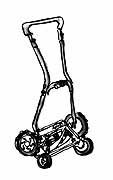
|
Late August in the hinterlands, and the urban influx mulls our
wine. Night air raises a shiver, a parade of downpours has revived
the grasses, and summer visitors are squeezing out the last ounce
of vacation. In their wake we confront our provincialism. |
| We've been pigging on fresh corn for the last three weeks, and
the pesto farmers are up to their necks in basil. Our second planting
of peas is up six inches and groping for a purchase. Hay rolls
elucidate the meadows, and the birds are flocking. Trees on the
margin are starting to show their colors. We're trying to wave
ours. |
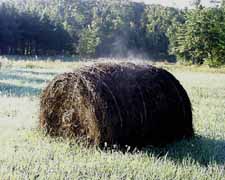
Steaming Hay
|
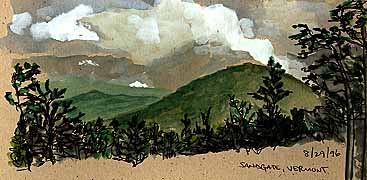
Vermont
|
Swamped in the seasonal inrush of the larger culture we can lose
our sense of isolate identity, and city angst tugs our ankles.
This week Jim and I drove over to southern Vermont and visited
Steve and Ben in Sandgate. Three boomers and a boy up a backhill
in postcard country. Vermont always makes Maine look a bit seedy,
and Vermonters always seem way sophisticated. Everyone reads "The
Times" and knows the score. I came away unsettled, uncertain about
being a local artist on the fringe. |
| Steve built his house on the North side of Sinners back in the
Seventies, when so many of us were in flight from a failed cultural
revolution. Country carpentry seemed a sane alternative to head
butting on the mean streets. But Steve went back into the stews,
while Jim and I sank into localism. Pushed our boulders up different
slopes. Twenty years later we see the world from disparate hilltops.
We still share a Sixties bias, and are glad of the company, but
our styles are divergent. |
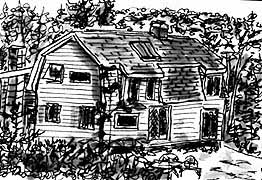
|
Steve's neighbor, Karl, is a successful urban artist who lives
up a two-track, but moves with the shakers. Some Maine artists
manage the same stunt, but it always makes my head spin to watch.
Converse with Karl was full of awkward misapprehensions. My questions
managed to rub him the wrong way, and he left me feeling inadequate.
O yes: now I remember: the urban fizz.
| How different an artist's life is when it's not measured against
a city scale. Karl objected to my calling him a "colorist". I
was merely trying to describe his technique of building images
out of vibrant multiple hues, he winced at being categorized as
an adherent to some school of painting. A city artist must struggle
against the constraints of critical analysis, being lumped as
a this or a that. Rural artists are beyond the pale, and critical
definitions are beside the point. Nobody is reviewing us. I couldn't
find a common parlance with Karl. |
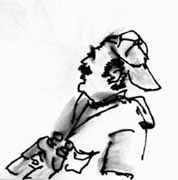 |
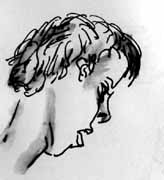
|
Karl does shows in Tribeca, has book illustration contracts, is
a known commodity in the art biz. This is how America thinks of
artists, when it bothers to. We are supposed to master our craft,
find a market niche, promote ourselves, turn a profit, get famous.
Art as commodity in a commercial society. Artists as performers
in the cultural circus. Those of us who aren't getting rich, or
getting puffed, are obvious failures. "Who are YOU?" is the defining
question. The work itself is almost beside the point. |
This alienation from esthetic purpose is compounded by the urban
squeeze. To survive in town you have to shove and bump. Shout
your individualism, outwit the competition, be tough. A regime
hard on quiet introspection, collegial conviviality, and the warm
embrace. I generally feel shouted at, roughed up, and put down
after an urban interlude. I don't get the feeling that urban arts
are full of joy, that urban artists have a sense of community,
or that "successful" work is fumbling toward transcendent ends.
City art appears to be about importance, alienation, and the holy
ME.
|
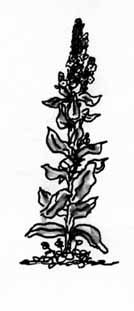
|
Karl's most recent show was a collection of landscapes and self
portraits. The work is striking. Bold colors make the images jump
off the canvas. Even the somnolent pastoral is vivid. Very southern
Vermont, perhaps. Up in the hills, but within earshot of the buzz.
| Not that we escape the noise in Maine. Carlo has been muttering
over the artist's role at recent figure study sessions. An old
artist friend of his committed suicide this month, and Carlo insisted
it was his last artistic act, a grand self-expression. Not knowing
the particulars it's unfair to judge, but the instinct of some
of us was that suicide is the ultimate unkindness, cruel to those
you love. Not a noble artform. Which brings us to the nub: is
the artist's work about individual expression, or is it a vehicle
for something transcendent? Is the artist's life a bellowing in
the wilderness, or part of a social colloquy? |
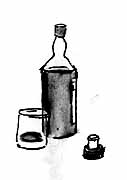
|
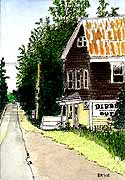
Bibber's Wholesale
|
In an increasingly hierarchical society that tells us only a few
artists are important, that it's all about their unique sensibilities,
the notion of art as a communal act seems arcane. At least in
the city. If you don't inflate your ego uptown, you get flattened.
But fame is as fleeting as it's rare, and the brass ring is hardly
worth the grasping, if the cost is alienation. The sense of failure
that goes with the name game is oppressive. Small wonder an urban
artist might feel suicidal. |
| Down home we're all unknowns, and can chase other birds. Not to
say rural art isn't full of self-expression. What else is style,
after all. But it doesn't have to be ABOUT self, and what a relief
that is. There was a time when the city art scene seemed to be
an exciting cauldron of hot ideas and new ways of seeing, but
it got swallowed by the commercial imperative and the name game.
In the Sixties we felt there was a common purpose in our extravagances,
now it's every odd duck for himself. Except out here on the edge,
where we tend to hang out together and honor our mutual absurdity. |
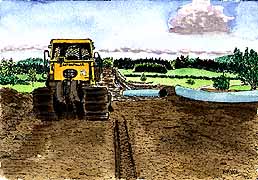
Pipeline Cat
|
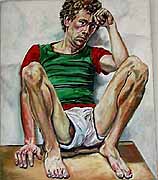
|
A show of Carlo's drawings is opening in Portland this Friday,
and the tribe will turn out in full feather. Carlo, more than
any of us, is tortured by the urban anguish, even at this remove.
He craves critical recognition, even while he affronts the taste
makers. After 30 years in the puckerbrush he still looks to New
York as the holy city. He can't stop measuring himself against
sky scrapers, and his oils reflect a sophisticated sensibility.
But they're witty, too. Taking the Mickey out of Lucien Freud.
Making us confront our inhibitions about flesh. Large and difficult
paintings, so blatantly exposed, but so unerotic. His drawings
are simple studies, and their colorist vibrance is a delight.
In some ways they grab you quicker than his oils, because they
don't have the time to take them self seriously. I'm posting a page of Carlo's paintings in honor of his drawings exhibit. |
| For me the unabashed nakedness of Carlo's vision makes him the
boy in the tale. He really sees the emperor's new clothes. Look,
look, look.. draw, draw, draw.. is his mantra. Look at how it
really is, so intently that embarrassment is beside the point.
When Carlo pushes the button on the timer in life drawing sessions
he calls: "We're working." And the work is about seeing. And revealing.
If it's all just a pose, expose it. If the emperor is naked, show
it. Let the critics Fall where they may. |
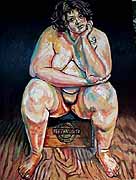
|











